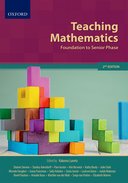Teaching Mathematics: Foundation to Senior Phase is the second edition of the first South African text on mathematics methodology. It includes reference to the South African mathematics syllabus as contained in the Curriculum and Assessment Policy Statement (CAPS) and focuses on typical challenges faced in the mathematics classroom in South Africa and southern African countries.
Teaching Mathematics also contributes to the Africanisation of the discipline of mathematics education by stimulating thought and research about African perspectives and indigenous knowledge, including the language of location and the importance of using place-based examples in the classroom. The text makes use of African contexts in the teaching of mathematics, using
African examples to which learners can relate, such as local names, artefacts, and elements of cultural heritage.
Teaching Mathematics has a unique structure that takes readers through the stages of how learners learn mathem at ics, and how to teach mathematics, before drilling down to specific themes. The book provides practical pedagogy that will connect student teachers to the bigger picture of mathematics. This textbook will encourage student teachers to feel positive about mathematics and their role in teaching it, and to enter the classroom confident that they are equipped with the practical knowledge, skills and strategies for teaching mathematics.
Features
- A rich selection of features that help students feel confident about teaching mathematics, such as vignettes which offer exploratory questions to engage student teachers with the underlying themes and concepts of the chapter, Big Ideas lists that introduce each chapter’
- s main concepts and encourage mathematical thinking, key terms, review questions and websites
- Consider and discuss your maths and Consider and discuss your teaching boxes that will get students actively involved in tutorials and focus on content and pedagogical knowledge respectively
- For the classroom activities that student teachers can take with them into the classroom
- Teaching challenges boxes that address specific issues that teachers encounter in the classroom.
- Pedagogical features have
been streamlined with a greater focus on practical application within the classroom, teaching challenges, and clearer differentiation between content knowledge and learning to teach mathematics.
- Chapters covering the same topic at different
Part 1: Setting the scene
1Understanding the nature of school mathematics
2Learning mathematics
3Teaching mathematics
4Becoming a professional teacher of mathematics
Part 2: Understanding the challenges and opportunities
5Thinking mathematically
6Communicating mathematically
7Representing mathematically
8Assessing and reporting
9Diversity
Part 3: Exploring the Big Ideas in mathematics
10Numeracy in the curriculum
11Developing a sense of number and algebra
12Developing a sense of measurement and geometry
13Statistics and probability
Part 4: Mathematical concepts for the Intermediate and Senior Phases
14Algebraic thinking
15Introducing place value
16Numbers and numeration
17Addition, subtraction and additive thinking
18Multiplication, division and proportional reasoning
19Measurement concepts
20Geometric thinking and concepts
21Data handling: Statistics and probability
It is suitable for Bachelor of Education (B.Ed), Advanced Diploma in Education (ADE), and Postgraduate Certificate in Education (PGCE) students who are enrolled in mathematics methodology modules from Foundation to Senior Phase at universities and universities of technology. The book is also appropriate for those conducting research in mathematics education and mathematics teacher education as it offers extensive information and references on the subject.
